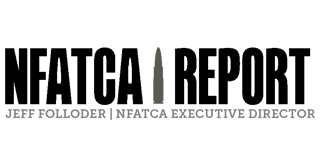By JEFF FOLLODER
One would think that the beginning of October, when this article was penned, would herald the arrival of cooler temps, changing colors and preparations for the onslaught of kids dressed in costumes, soliciting candy at the doorstep. Instead, I helped to officiate the National Night Out program in my community in 90° heat, with mosquitoes in full flight and me considering the ever-present stupidity of short-barreled long arms still being a part of the heavily regulated constituency of the National Firearms Act (NFA). You read that right. Amidst the sweltering heat and community safety displays, I was struck by the absurdity of regulating certain weapons which was created as all but an afterthought.
To provide a little context: The NFA’s original intent was most pointedly aimed at eliminating handguns. The documentation of congressional proceedings in 1934 clearly shows this to be the case. Handguns were (and still are) the overwhelming first choice of criminals and ne’er-do-wells. Congress wanted to do something! Sound familiar? Rancorous debate ensued, and industry and the public convinced Congress that restricting handguns would be akin to throwing out the baby with the bathwater and that the lawful utility of handguns far outweighed the criminal use of them. Additionally, many of the Congressmen were handgun shooters and collectors. So, handguns were left out. But Congress could not let a good opportunity go to waste. So, they managed to do something and listed a bunch of items for regulation of questionable import. And that is how short-barreled rifles and shotguns, as well as suppressors, are included in the NFA. The “Any Other Weapon” category was the direct answer on handgun banning—if it was smoothbore, the bullets could not be forensically traced, so the compromise was that smoothbore handguns must be registered, and pen guns other oddities ended up in this category.
Back to National Night Out. It is an event that is celebrated in many communities throughout the United States. Folks get together, sometimes meeting for the first time, to learn about safety and law enforcement in their area. Sometimes local officials, law enforcement and/or vendors are present. It’s usually accompanied by snacks and attractions for the kiddos. My neighborhood sought high marks. Our neighborhood sheriff’s deputy was there for meet and greet. Other deputies arrived to shake hands. The mounted patrol showed up with horses so that the kids (and some of the adults) could love on the horses and take selfies. And then one of the sheriff’s SWAT teams showed up in its 38,000-pound armored vehicle. Three deputies, one giant vehicle and a bristling display of tactical and rescue gear.
After the general public wrapped up their tour of the display, I had the chance to chat with one of the SWAT deputies about some of the weapons. “Penn Arms rotary grenade launcher. Nice! I have one. What munitions do you use?” “Nice selection of less-lethal for the shotties.” “Good looking short-barreled rifle. I guess that comes in handy when you guys are all saddled up with body armor.” The deputy then informs: “That’s not an SBR. That’s my personal weapon, and it’s a pistol.” It was an AR-style pistol with a brace.
He went on to inform me that the department will allow deputies to supply their own weapons as long as they can qualify with them. He went on to describe the utility of the shorter barrel in close quarters, and then he lamented the difficulty of getting “a real SBR” that he could use in his law enforcement duties. The department is hesitant to issue NFA-duty weapons to their deputies. It’s impossible to get his boss (the sheriff) to approve the Form 4, and he did not have time for the hassle of setting up a trust. I took the opportunity to explain to him that the need for Chief Law Enforcement (CLEO) sign off on a Form 4 had not existed for years, thanks to the NFATCA. That process improvement also meant that he didn’t need a trust to get around the requirement for the signature on the Form. I then went on to explain that he could either outright purchase a factory SBR, file a Form 4 and wait about a year (without a CLEO signature) or use a Form 1 that could be filed electronically and therefore would allow him to assemble his own SBR. That would only take a month(ish). The deputy learned something about the current process, but he also struck a note with me about the absurdity of having these weapons on the NFA in the first place. “It’s stupid that these are regulated. I’m a recognized and highly trained peace officer, and I have to jump through these hoops just to do my job.”
He’s right. The hoops are stupid. Short-barreled long arms are seldom used in crimes and represent an infinitely small threat to public safety. They shouldn’t be included in the NFA and neither should suppressors. Yet here we are. Like many bits of legislation that roll out of the hallowed halls of Congress, this law is a chunk of convoluted and complicated tripe that serves no real public safety interest.
The NFATCA continues to work toward making things right. It takes lots of time and lots of money to keep the efforts moving forward. We would like your help to continue that effort! Is there something on your mind that you’d like to discuss? Drop us a note at info@nfatca.org. We appreciate your continued support and encourage you to join or renew your membership today at nfatca.com.
| This article first appeared in Small Arms Review V24N1 (Jan 2020) |












